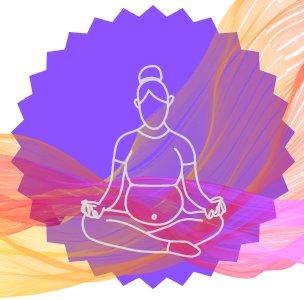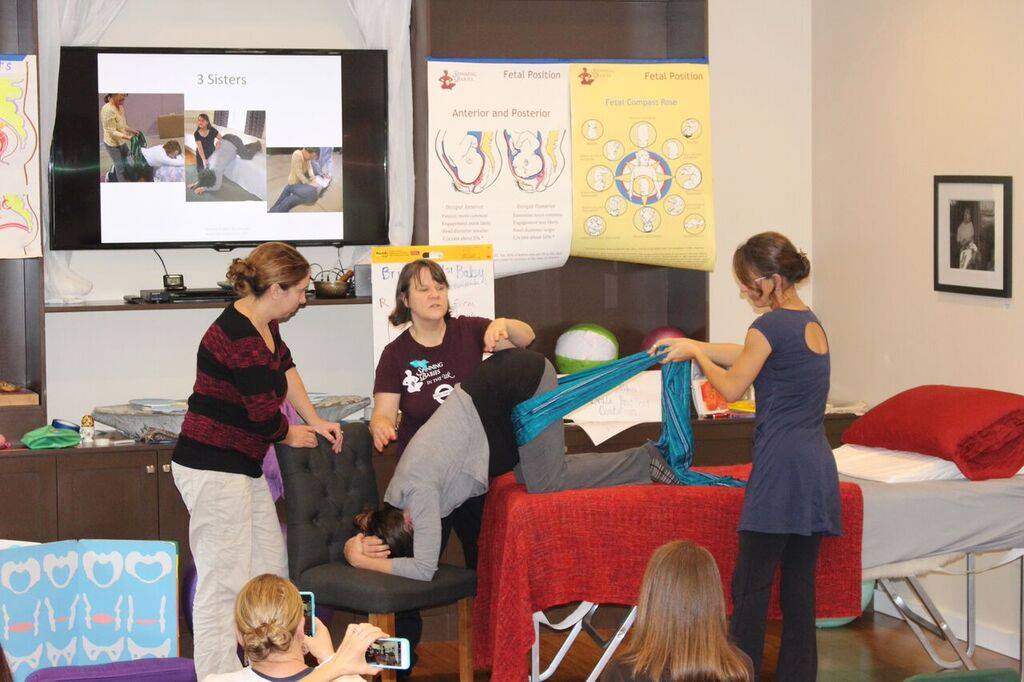Prenatal Yoga & Pain Management

I think most would agree that labor is painful. Having the expectation that it will be painful going into it, I think, is useful and will less likely lead to failed expectations, if one is going in expecting a mildly painful experience full of bliss. Pain can be tricky. It’s typically signaling to us that something is wrong, and we need to stop doing that thing. The pain of labor is completely normal and is usually a sign that things are progressing, that the cervix is changing, and that the uterus is contracting stronger and stronger.
In their book, Mindful Birthing, Nancy Bordacke uses the term Transformational Pain to describe the normal sensations that one experiences during labor. Bordacke says,
“We need a completely different category for the pain of childbirth, so I offer the concept of transformational pain. Transformational pain is normal pain. It is the pain of living in a mortal body, a body that exists in Horticultural time, a body that is birthed, grows, at times experiences illness, the eventual pains of aging, and ultimately death. Physical pain is just part of the business of being alive. When we give birth, change is taking place very rapidly – anywhere from a few hours to a day or more – and when a body changes so quickly, we experience intense transformational pain.”
Often the fear of pain initiates the “fight or flight” response to take hold of our bodies. When this happens in labor, the increased production of adrenaline by the hypothalamus crowds out many of the body’s natural coping chemicals, oxytocin and endorphins. In addition, blood circulation increases outwards towards the extremities of the body and away from the organs in the central region of the body, including the uterus. The decreased circulation in the uterus can make uterine contractions slow down and lose their rhythm and cause contractions to be more painful.
The practice of Prenatal Yoga utilizes many techniques to help a person cope with uncomfortable and sensational moments.
Some of these include:
- Breath observation. Simply observing the breath can be an incredibly powerful tool when it comes to pain management. As mentioned above, often the fear of pain initiates the stress response to send adrenaline coursing through the body, getting it ready to fight or flee, and involves an elevation in the breath pattern with more shallow exhalations. When one is in the practice of witnessing their breath, they will be able to better catch when their breath pattern has changed and begin taking deeper breaths with longer exhalations. A deeper breath also involves breathing downward and outward versus up high in the chest. Breathing in this way will allow their body to get back into its parasympathetic state of greater peace and the state of mind that is ideal for laboring and allows pain coping chemicals to be released.
Throughout a prenatal yoga class or session, there are many reminders to observe the breath while moving and resting, and various types of breathing exercises are practiced to help calm the body. People often ask in prenatal yoga, how should I breathe during labor, and my answer is usually to breathe normally and to stay cognizant of the breath so that it can be there to support you through challenges. If you notice that your breath is becoming shallow, encourage yourself to slow down your breath and keep the exhales complete.
- Practice how to Relax. As easy as it sounds, relaxation can be quite challenging sometimes. While our partners or friends may have the best of intentions when they say, “Just relax,” this may be quite triggering for some and bring on the opposite results. Sometimes we may also think after a few minutes of wiggling around in a restful posture or trying to sit quietly, “I’m not very good at relaxing,” but all this means is that we need to figure out how to relax. The simple meaning of Yoga is Union. This can be understood as a union between the body and the mind. The mind is the body and vice versa, but often in life, we may feel like the mind is sprinting all over the place and have little awareness of the actual physical body.
There are many ways to bring the mind back into the body, where union and therefore relaxation occurs, but I usually encourage people to start by observing their breath.
- Explore Coping Techniques in Challenging Postures. Many prenatal yoga postures and exercises can be physically challenging. While these pregnancy-safe exercises are providing tone and pelvic stabilizing opportunities, they are also giving the pregnant person a practice round at being in an uncomfortable position and needing to figure out a way to cope that suits them best. It may be counting the breaths, or softening the face and shoulders, or repeating a phrase or word that also matches their long rhythmic breathing. There are endless techniques, and we explore many of these in classes and sessions. The practitioner begins to hone in on which ones work for them in the midst of challenge and which ones do not seem as useful. We often experiment with techniques in the “Wall Sit” while squeezing a block between the upper inner thighs. We may begin with shorter holds of around 30 seconds for 1-2 sets, and then we’ll gradually build into 2 sets of 1 minute each, about the length of an active labor contraction, and building up to 90 seconds to 2 minutes long, more the length of transition contractions, for 1-2 sets.
- Build Focus in Pregnancy-safe Kundalini Exercises. This last area of focus builds from the previous method. Kundalini sets or Kriyas typically involve doing 1 thing repetitively for a few minutes or more. Some pregnancy-safe sets include calf-strengthening by moving onto the tippy toes and back down, for a few minutes, circling the arms for a few minutes, or coming in and out of the deep squat, Malasana, for a few minutes. There are numerous ones to try, and most of them require much focus and motivation to get through. Once the exercise is complete, there is a sweet moment of rest where the practitioner may experience the release of pain-relieving endorphins that sometimes feels “blissful.” Labor offers these natural breaks between contractions, and this is how one may experience bliss during childbirth – by riding the wave of endorphin release caused by the pain experienced in contractions followed by a short rest to feel and be in the moment.







